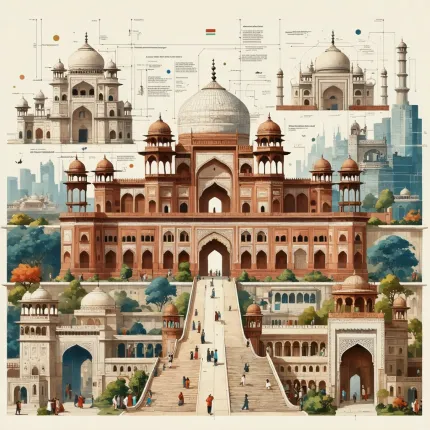
Stepping Into Time: Why India’s Historical Monuments Demand Our Attention Today
Have you ever paused in front of a centuries-old monument and wondered about the stories etched into its stones? India, a land steeped in history, offers a breathtaking tapestry of such marvels—each narrating tales of valor, artistry, and cultural evolution. Yet, in the fast-paced world of 2025, where digital screens dominate our gaze and modernity often overshadows tradition, the question arises: Are we truly preserving and appreciating these architectural treasures?
Take, for instance, the Qutub Minar in Hindi. Towering over the bustling streets of Delhi, this majestic minaret is not just a symbol of architectural brilliance but a silent witness to centuries of history. Despite its grandeur, many younger generations know little about its origins, significance, or the meticulous craftsmanship involved in its creation. Similarly, iconic sites like Agra Ka Kila stand as proud reminders of India's imperial past but face challenges ranging from environmental wear to the pressures of modern urbanization.
Moreover, questions like Tajmahal Kisne Banaya Tha often spark curiosity but also highlight a gap in widespread historical knowledge. Understanding who commissioned and built the Taj Mahal doesn't just satisfy trivia—it connects us to the human stories behind these monumental feats of engineering and love.
Why the Urgency? The Vulnerability of Our Past in a Rapidly Changing World
Despite their grandeur and significance, India’s historical monuments are vulnerable. Pollution, urban sprawl, and even tourism, when unmanaged, threaten their structural integrity and the very essence of their stories. It’s a paradox: these sites attract millions eager to witness history firsthand, yet the influx can hasten their deterioration.
Consider the impact of environmental factors on the Qutub Minar in Hindi—acid rain and air pollution have caused discoloration and surface degradation. And what about Agra Ka Kila? Beyond the obvious wear and tear, it grapples with conservation challenges that require urgent attention to prevent irreversible damage.
Furthermore, there's a subtle cultural erosion happening. As modern narratives dominate, the nuanced histories behind these monuments risk being reduced to mere tourist checkboxes. The rich tapestry of stories—from who built them, like the answer to Tajmahal Kisne Banaya Tha, to the architectural innovations and political contexts—can slip away from collective memory if we don’t actively engage with and preserve these legacies.
Rediscovering and Safeguarding India’s Architectural Heritage: A Journey Worth Taking
But all is not lost. Across India, efforts to revitalize and protect these historical monuments are gaining momentum. From government initiatives to community-led conservation projects, there’s a growing recognition that preserving these sites is about more than just bricks and mortar—it’s about maintaining a living connection to India’s soul.
In this article, we’ll embark on a fascinating exploration of some of India’s most treasured historical monuments, including the stunning Qutub Minar in Hindi, the formidable Agra Ka Kila, and the eternal Taj Mahal. We’ll uncover their histories, delve into the questions like Tajmahal Kisne Banaya Tha, and highlight ongoing preservation efforts that ensure these icons continue to inspire future generations.
Whether you’re a history buff, a curious traveler, or someone passionate about cultural heritage, understanding the stories and challenges behind these monuments enriches our appreciation of India’s diverse legacy. Ready to step back in time and witness the grandeur that has shaped a nation? Let’s begin.

Historical Monuments of India: Explore India’s Historical Monuments Preserving Its Legacy in 2025
What are the most iconic historical monuments in India?
India is home to a vast array of historical monuments that showcase its rich cultural heritage, architectural brilliance, and historical significance. Among the most iconic are the Taj Mahal, Qutub Minar, Agra Ka Kila, Red Fort, and many others. These monuments not only represent different eras—from the Mughal period to ancient kingdoms—but also embody the country's diverse artistry and craftsmanship.
Understanding these monuments involves exploring their origins, architectural styles, and the stories they tell about India’s past. For example, the Tajmahal Kisne Banaya Tha is a question often asked by visitors eager to know the history behind the Taj Mahal’s construction.
Who built the Taj Mahal? – Understanding "Tajmahal Kisne Banaya Tha"
The Taj Mahal, one of the Seven Wonders of the World, was commissioned by the Mughal emperor Shah Jahan in memory of his beloved wife Mumtaz Mahal. Construction began in 1632 and took around 22 years to complete, involving thousands of artisans and craftsmen from across India, Persia, and the Ottoman Empire.
The monument is a masterpiece of Mughal architecture, blending elements from Islamic, Persian, Ottoman Turkish, and Indian architectural styles. Its white marble facade, intricate inlay work with precious stones, and symmetrical gardens symbolize eternal love and devotion.
Understanding who built the Taj Mahal also helps us appreciate the technological and artistic advancements of the time, such as the use of advanced waterworks for the gardens and the precise geometric planning of the complex.
What is the significance of Qutub Minar and how is it described in Hindi?
The Qutub Minar in Hindi is written as "क़ुतुब मीनार," and it stands as one of Delhi’s most prominent historical landmarks. It is the tallest brick minaret in the world, standing at 73 meters, and was built in the early 13th century by Qutb-ud-din Aibak, the founder of the Delhi Sultanate.
The Qutub Minar is significant not only for its height but also for its intricate carvings and inscriptions in Arabic and Nagari scripts. It marks the beginning of Muslim rule in India and is part of a larger complex that includes the Quwwat-ul-Islam Mosque, one of the earliest examples of Indo-Islamic architecture.
This monument’s construction was both a symbol of political power and religious dominance, showcasing the synthesis of various architectural traditions.
What is Agra Ka Kila, and why is it important?
Agra Ka Kila, or the Agra Fort, is a UNESCO World Heritage site and a historic fort in the city of Agra. Built primarily during the reign of Emperor Akbar in the 16th century, the fort served as the main residence of the Mughal emperors before the capital shifted to Delhi.
The fort is a massive red sandstone complex that includes palaces, mosques, audience halls, and beautiful gardens. Its architecture reflects a blend of Hindu and Islamic styles, symbolizing the cultural fusion of the Mughal era.
Agra Ka Kila played a crucial role in Indian history, witnessing numerous battles and events, including the imprisonment of Shah Jahan by his son Aurangzeb. It remains a testament to Mughal military ingenuity and architectural grandeur.
Why is it important to preserve India’s historical monuments in 2025 and beyond?
Preserving India’s historical monuments is essential for several reasons:
- Cultural Heritage: These monuments are tangible links to India’s diverse past, representing various religions, dynasties, and artistic expressions.
- Tourism and Economy: Historical sites attract millions of tourists annually, contributing significantly to the local and national economy.
- Education and Research: They serve as open-air museums, helping scholars and students understand historical contexts, architecture, and archaeology.
- Identity and Pride: These monuments foster national pride and identity, reminding citizens of their shared heritage.
In 2025, with increasing urbanization and environmental challenges, conservation efforts must focus on sustainable tourism, advanced restoration technologies, and community involvement to ensure these treasures endure for future generations.
How can visitors experience these historical monuments authentically?
To truly appreciate India's historical monuments, visitors should consider:
- Guided Tours: Engaging with knowledgeable guides who can explain the historical context, architectural details, and anecdotes behind each monument.
- Local Language Exploration: Understanding key terms and inscriptions, such as reading about Qutub Minar in Hindi, enhances cultural immersion.
- Visiting During Off-Peak Hours: To avoid crowds and experience the sites in a more contemplative atmosphere.
- Participating in Cultural Events: Many monuments host festivals, light and sound shows, or historical reenactments that bring the past to life.
By combining historical knowledge with immersive experiences, visitors can connect more deeply with India’s monumental legacy.
Conclusion: Embracing India’s Monumental Legacy in 2025
India’s historical monuments like the Taj Mahal, Qutub Minar, and Agra Ka Kila are not just architectural marvels; they are storytellers of a vibrant and complex past. Understanding who built these monuments and why, such as answering Tajmahal Kisne Banaya Tha, enriches our appreciation of their significance.
As we move further into 2025, the preservation and exploration of these sites remain vital. They serve as bridges between centuries, connecting us to the stories, cultures, and innovations of our ancestors. Whether you are a history enthusiast, a student, or a traveler, delving into the legacy of India’s historical monuments offers an invaluable journey through time.

